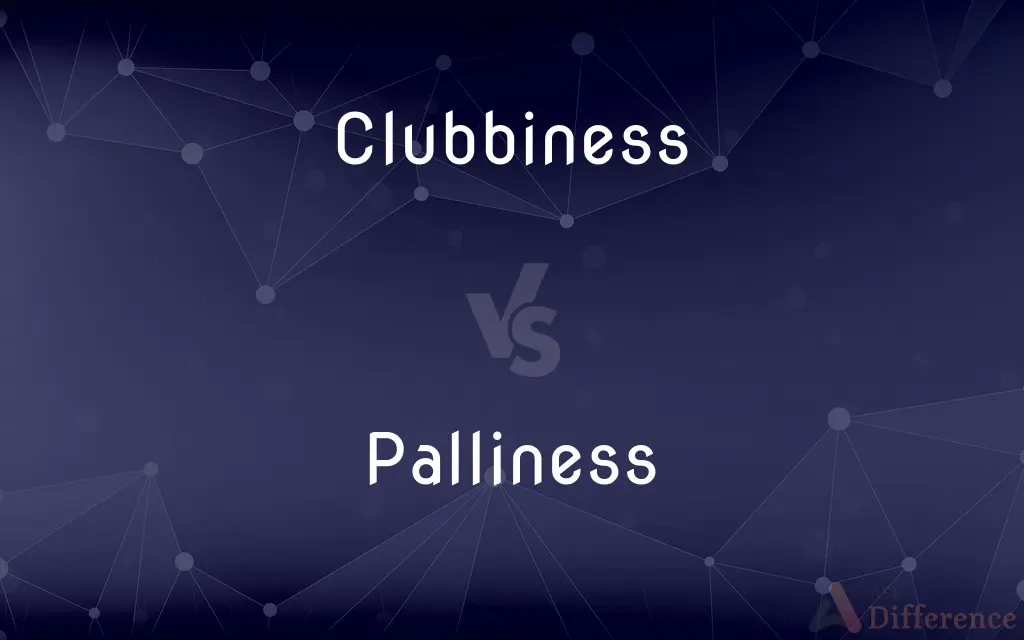Clubbiness vs. Palliness — What's the Difference?
By Tayyaba Rehman — Published on October 22, 2023
Clubbiness relates to the quality of being sociable and forming close-knit groups; palliness refers to a state of friendly, informal familiarity. Neither term is standard English, so usage may vary.

Difference Between Clubbiness and Palliness
Table of Contents
ADVERTISEMENT
Key Differences
Clubbiness refers to the characteristic of forming exclusive, tight-knit, and sociable groups. It implies a strong sense of unity and closeness within a particular club or organization, potentially limiting interaction with outsiders. On the contrary, palliness is typically related to casual and friendly relationships, denoting a level of informal familiarity and ease between individuals, irrespective of any club or formal group setting.
Clubbiness usually pertains to structured or organized groups with specific interests or goals. It can signify a selective or exclusive environment, where membership may have its privileges and restrictions. Conversely, palliness is more about easy-going and informal friendships, highlighting comfortable interactions and the absence of formal constraints, possibly without any common goal or shared interest.
The concept of clubbiness often involves mutual interests, shared goals, or common values that bind the members together. It could be seen as positive, promoting camaraderie, but also negative, hinting at exclusivity and cliquishness. Palliness, meanwhile, usually connotes simple, relaxed companionship and might lack the depth or the shared commitments often found in clubbiness.
Clubbiness can be a reflection of one's social identity, suggesting a sense of belonging and shared experiences within a particular group or organization. It might involve formalized interactions and activities. Palliness, in contrast, is usually devoid of formal structures, symbolizing an uncomplicated, easy friendship that might or might not involve shared experiences or identities.
In sum, clubbiness is more about formal, structured, and possibly exclusive interactions within a group, while palliness emphasizes informal, friendly, and relaxed relationships without the necessity of a structured environment.
ADVERTISEMENT
Comparison Chart
Definition
Inclination to small, exclusive, and social groups
State of informal, friendly familiarity
Formality
Usually formal and structured
Typically informal and unstructured
Exclusivity
Can be exclusive and selective
Non-exclusive and open
Depth of Relationship
Might involve deep, shared commitments
May lack depth and commitment
Associated Setting
Specific clubs or organizations
Any casual, informal setting
Compare with Definitions
Clubbiness
Clubbiness is the preference for, or comfort in, close-knit and exclusive groups.
His clubbiness made him a popular member of exclusive societies.
Palliness
Palliness implies a relationship devoid of deep commitments or shared goals.
Their palliness made for pleasant, if not particularly profound, interactions.
Clubbiness
Clubbiness signifies a sense of belonging and unity within a selective group.
The members' shared values and clubbiness set them apart from others.
Palliness
Palliness is an informal, friendly, and easy-going familiarity between individuals.
Their palliness was evident in their relaxed and comfortable interactions.
Clubbiness
Clubbiness can refer to the exclusiveness and selectiveness of social clubs.
The clubbiness of the golf club was evident by its restrictive membership policies.
Palliness
Palliness denotes casual and uncomplicated companionships.
The neighbors displayed a wonderful palliness, always ready to lend a hand.
Clubbiness
Clubbiness implies a structured, organized interaction within a group setting.
The frequent events and discussions enhanced the clubbiness of the book club.
Palliness
Palliness signifies a lack of formality and structure in relationships.
The simplicity and palliness of their friendship were refreshing to see.
Clubbiness
Clubbiness denotes a shared identity and mutual interests within a group.
The shared passion for music fostered a unique clubbiness among the band members.
Palliness
Palliness can represent easy, open friendships without exclusivity or selectiveness.
Their palliness was welcoming, inviting everyone into friendly conversation.
Clubbiness
Typical of a club or club members.
Palliness
Quality of being pally.
Clubbiness
Friendly; sociable.
Clubbiness
Clannish; exclusive.
Clubbiness
The state or quality of being clubby, of resembling a small, selective group
Common Curiosities
Can clubbiness occur in any group?
Yes, clubbiness can occur in any group where there is a sense of unity and shared interests.
What is clubbiness?
Clubbiness is the characteristic of being inclined to form close-knit, exclusive, and sociable groups.
Is clubbiness exclusive?
Yes, clubbiness often involves exclusivity and selectiveness within groups or clubs.
How is clubbiness reflected in interactions?
Clubbiness is reflected through structured, organized, and possibly formal interactions within a group.
Can palliness have depth?
Palliness usually connotes casual companionships and might lack the depth found in more structured relationships.
How is clubbiness developed?
Clubbiness is developed through shared interests, values, and structured interactions within a group or club.
What does palliness mean?
Palliness denotes a state of informal, friendly, and relaxed familiarity between individuals.
Are clubbiness and palliness opposite concepts?
They aren’t exactly opposites but differ mainly in formality, structure, and depth of relationships.
Is palliness formal?
No, palliness typically implies informal, easy-going relationships without formal constraints.
Is clubbiness always negative?
No, clubbiness can be positive when promoting camaraderie but negative when overly exclusive.
Can palliness occur in structured settings?
Palliness typically occurs in more relaxed, unstructured settings without formal obligations.
How is palliness developed?
Palliness is developed through casual, relaxed interactions and easy-going companionships without formal constraints.
Does palliness require shared interests?
No, palliness doesn’t necessarily involve shared interests or commitments.
Can one experience both clubbiness and palliness?
Yes, one can experience clubbiness within structured groups and palliness in informal friendships.
Can clubbiness lead to palliness?
Yes, structured, formal interactions (clubbiness) can potentially lead to informal, friendly relationships (palliness).
Share Your Discovery

Previous Comparison
Constant vs. Control
Next Comparison
Mass Production vs. Mass CustomizationAuthor Spotlight
Written by
Tayyaba RehmanTayyaba Rehman is a distinguished writer, currently serving as a primary contributor to askdifference.com. As a researcher in semantics and etymology, Tayyaba's passion for the complexity of languages and their distinctions has found a perfect home on the platform. Tayyaba delves into the intricacies of language, distinguishing between commonly confused words and phrases, thereby providing clarity for readers worldwide.
















































